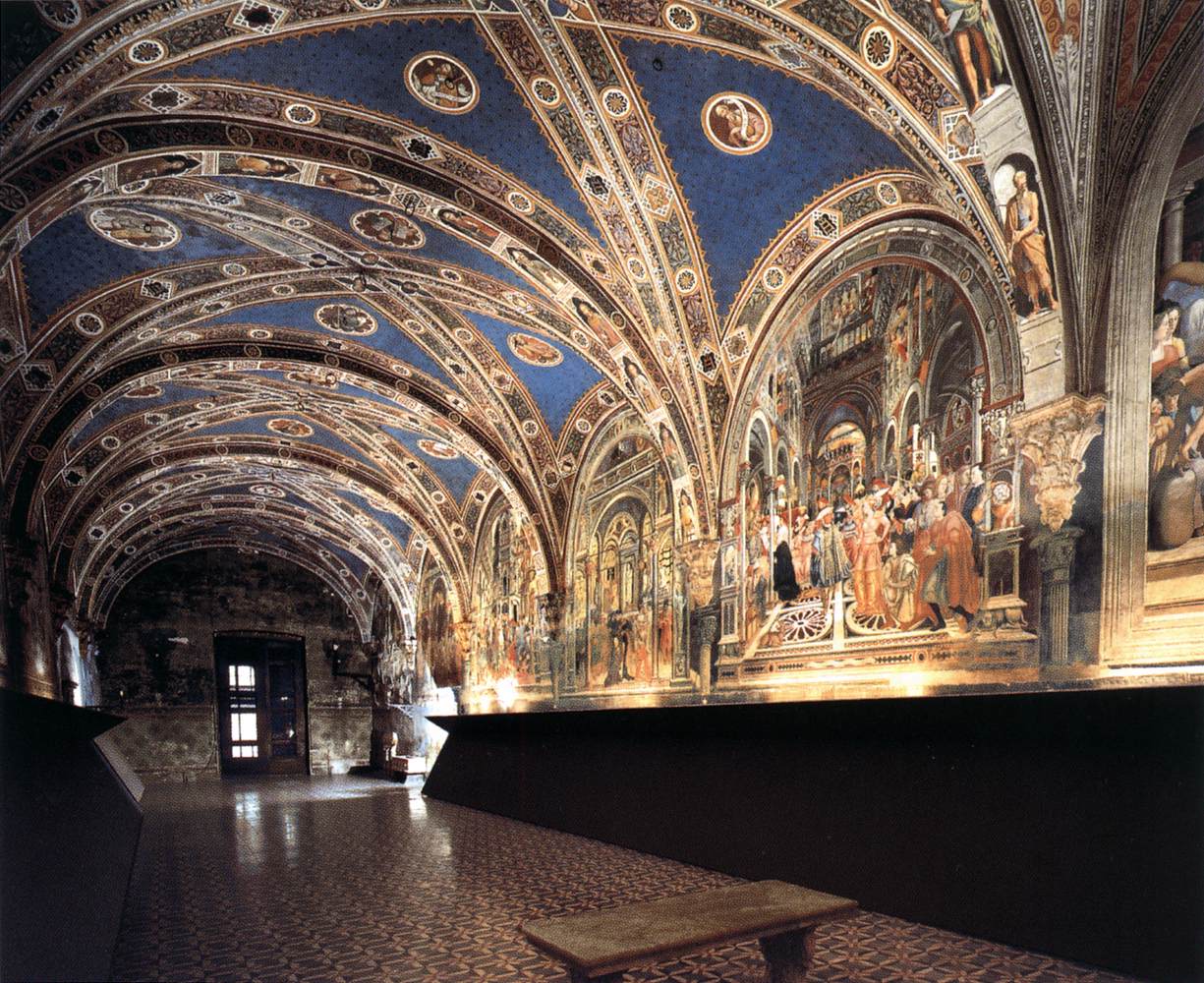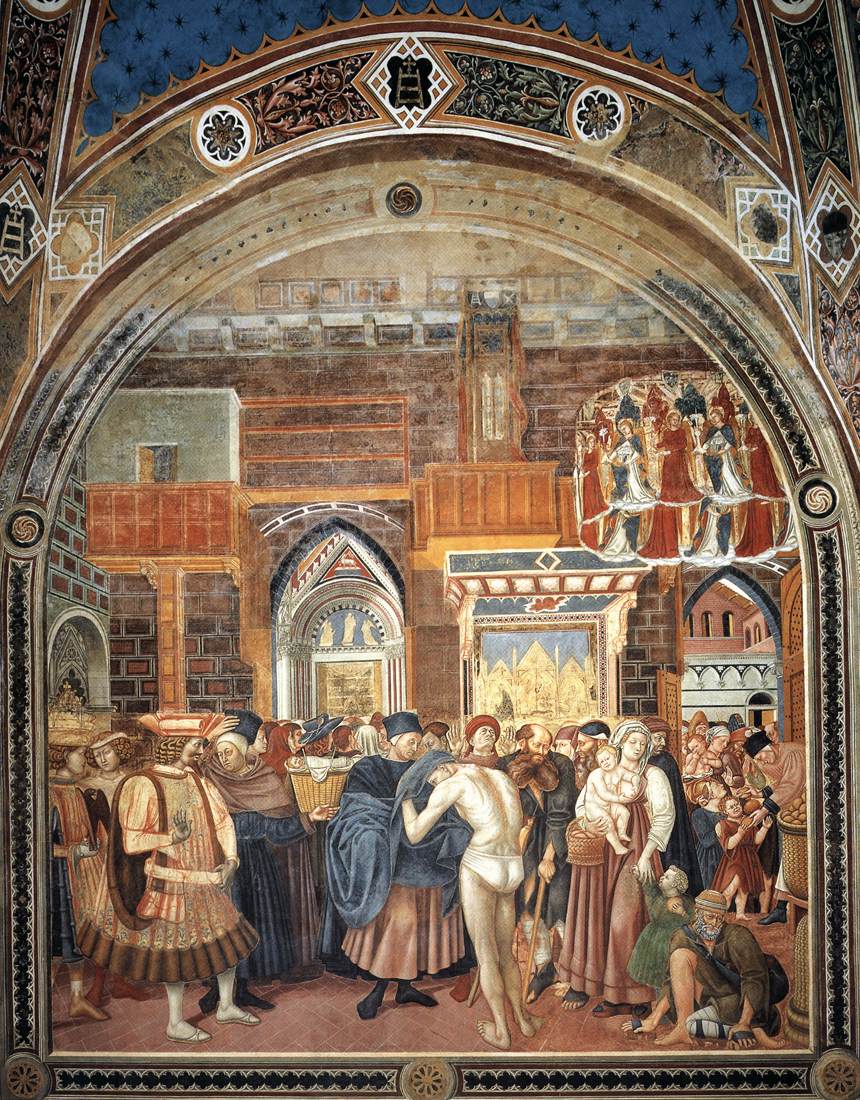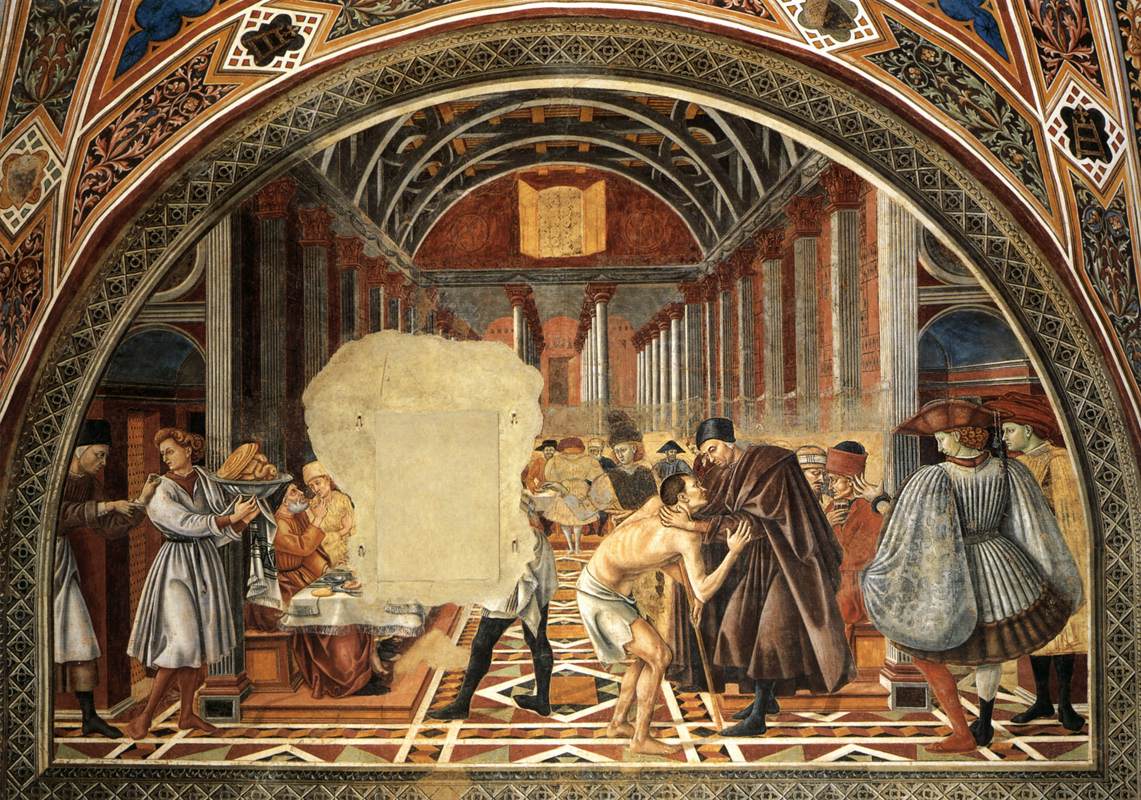John David Ike
Durham, North Carolina, United States
Ruth M. Parker
Atlanta, Georgia, United States
 |
| Domenico di Bartolo and others, Pellegrinaio of Santa Maria Della Scala, Siena, Italy. |
Introduction
Nestled in the rolling hills of Tuscany atop a jutted butte lies the historic city of Siena, Italy. Regarded as an important site in Renaissance art and a hub of Italian culture, this pastoral city also has a rich gastronomic tradition that has spanned centuries; warm bowls of ribolita, pappardelle con lepre, loaves of focaccia, and salted prosciutto are often paired with full-bodied wines and sweet desserts, all cucita a mano (crafted by hand) to be shared around a common table of family, friends, and guests. While recognized as a cultural epicenter, few visitors appreciate Siena’s contribution to the world of medicine and health. The city is also the site of Santa Maria della Scala, one of the first and most significant hospitals in Europe.
In the early twelfth century, there was an increasing flow of pilgrims on the one thousand kilometer Via Francigena, a well-traveled pilgrimage route from Gran San Bernardo to Rome. After priests initiated obligatory transfer of charitable works, this ospedale soon grew to become the area’s largest agricultural business whose land holdings were accrued to support its mission: duty to the poor (Baron 1990). In the pellegrinaio (central entrance hall) of the hospital is a magnificent early fifteenth century fresco cycle by Domenico di Bartolo that depicts the hospital’s founding and its role in caring for pilgrims, orphans, and the sick. Serving as an infirmary until 1975 and converted to a museum in 1995, the medieval hospital’s fresco cycle visually communicates not only the hospital’s purpose, but also the city’s enduring values and traditions. Two particular panels—Reception of the Pilgrims and Distribution of Alms and Feeding the Poor—convey the key role of food in health and healing across time. Before exploring these panels’ iconography, it is first important to establish how the arts, specifically visual art, communicate themes of health.
 |
|
| Domenico di Bartolo, Reception of the Pilgrims and Distribution of Alms, Early 15th Century, Pellegrinaio of Santa Maria Della Scala, Siena, Italy. |
Health literacy, the arts, and the role of context
Before the development of written language, societies and cultures communicated predominantly through images. Visual, not textual literacy was the shared language by which information, values, and traditions were communicated amongst people. As textual literacy advanced throughout much of Europe following the widespread dissemination of the printing press, the general populace, particularly those in poverty, remained largely illiterate. This made the visual transmission of information through art paramount. Images, not books, were the guides by which individuals sought instruction on matters of religious and civic life (The Toledo Museum of Art 2016).
Like visual literacy, health literacy is increasingly viewed as aligning complexities and tasks with people’s skills and abilities. Health literacy explores how people analyze, interpret, and act upon health-related information to better both individual and community health (Parker and Ratzan 2010). While most work in the health literacy field has been limited to the content of what is communicated, the context in which that information is transmitted is equally important. The arts are an underutilized resource for analyzing and appreciating the context in which communication about health takes place (Parker and Ike 2017).
Communicating through the arts
Domenico di Bartolo’s fresco cycle, when analyzed through the dual lens of health and visual literacy, communicates powerful themes of health and wellness. Painted in the early fifteenth century, shortly after the Black Death wiped out much of the European population, the frescoes communicate the duties of the hospital and transmit the values of the institution and the community at large.
A pilgrim walking the Via Francigena would enter Santa Maria della Scala’s pellegrinaio to be welcomed by a celestial blue ceiling with golden stars (Figure 1). The deep blues and elaborate decoration beckon the viewer to lift their weary shoulders and gaze upwards to appreciate the ethereal atmosphere it creates. But to a downtrodden pilgrim or sick citizen, the blue ceiling serves another purpose—it draws attention to di Bartolo’s fresco cycle, which sits between decorated spandrels portraying doctors of the patriarch, patrons of the hospital, and saints. Carefully displayed in chronological order, di Bartolo’s panels tell the story of the hospital’s founding, its close ties to the church and the community, and its role in caring for orphans, pilgrims, and the sick. To a visitor, the frescoes communicate essential health information: this is a place you will be cared for with compassion, fed, clothed, and hosted. Two of these panels further illuminate the role of food in the healing process.
In the panel Reception of the Pilgrims and Distribution of Alms, the artist illuminates the role of the citizen in providing for the poor (Figure 2). The scene is set in an entrance hall, presumably a visual re-creation of Santa Maria della Scala’s central hall. Through the central doorway there is a church, which serves as a reminder of the strong link between religious and civic virtue. Citizens distribute alms to prominently positioned pilgrims and the sick: a central figure exchanges his tattered robe for a fresh new garment, orphans and a mother with small children are given warm bread, and a lame man shuffles on a board to receive charity. This image communicates to a largely illiterate population, through direct iconography, the institution’s values to all who visit.
In a nearby panel, Feeding the Poor, Domenico di Bartolo highlights a different tradition paramount to the day-to-day functioning of the hospital: mealtime (Figure 3). While a large section of this fresco is damaged, the central theme of the piece is easy to decipher. Nutrition and the fellowship of sharing a warm meal is essential to healing. Unlike the hospitals of today, the scene depicts patients, pilgrims, and providers alike dining at a shared table. It speaks to the role of community and the humanity at the core of all relationships. Its message is timeless and the fresco offers instruction on a community’s duty to those at the margins of society. The arts afford an opportunity to understand context—values, traditions, and beliefs—and the unique ability of iconography and images to transmit timeless information related to health, the body, and healing.
 |
| Domenico di Bartolo, Feeding the Poor, Early 15th Century, Santa Maria Della Scala, Siena, Italy. |
Implications
In the present day, data increasingly suggests that while health-rendered services in hospitals and clinics improve health (medications, surgeries, etc.), the true health of a population is comprised of variables external to health systems. These “social determinants of health” include access to food, shelter, jobs and vocations, education, and other public health measures including resources and community infrastructure. In Santa Maria della Scala’s fresco cycle, these health-related factors are expertly communicated and linked in a single narrative. One does not need to read a briefing to appreciate the many components that contribute to a healthy populace.
In di Bartolo’s fresco cycle, we come to understand the origin of the word hospital—ospedale—which in Italian means “to host.” These frescoes communicate across time and reflect past and present values. In this ospedale, body and soul were healed through the selfless sharing of material goods, love, and shelter. These are the roots of our Western hospital tradition. History and the arts can continue to teach us about who we are as individuals and societies, and who we want to become in the future.
References
- Baron, J. H. 1990. “The Hospital of Santa Maria della Scala, Siena, 1090-1990.” BMJ 301 (6766):1449-51.
- Parker, R., and J. D. Ike. 2017. “Health Literacy and the Arts: An Intersection Worth Exploring.” doi: 10.31478/201707e.
- Parker, R., and S. C. Ratzan. 2010. “Health literacy: a second decade of distinction for Americans.” J Health Commun 15 Suppl 2:20-33. doi: 10.1080/10810730.2010.501094.
- The Toledo Museum of Art. 2016. “Why Visual Literacy?” [Video], accessed February 11, 2017. http://www.vislit.org/visual-literacy/.
JOHN DAVID IKE, MD, is an internal medicine resident at Duke University Hospital and Health System. He is a graduate of Davidson College in Davidson, NC where he earned a Bachelor of Arts in Art History and of Emory University School of Medicine in Atlanta, GA. His research interests include clinical cardiology and the intersection of the arts and health, specifically health literacy and health communication.
RUTH M. PARKER, MD, is a Professor of Medicine, Pediatrics and Public Health at Emory University School of Medicine. She is Senior Fellow in the Center for Ethics of Emory University. She is a health services researcher and clinician educator working at Grady Memorial Hospital in Atlanta, GA. She has long-standing interest in health literacy and has done years of work in clinical research, medical education, and health policy to advance our nation’s health literacy.

Leave a Reply